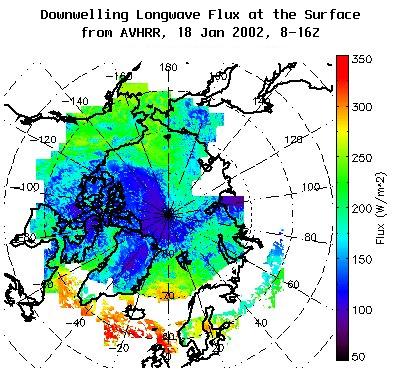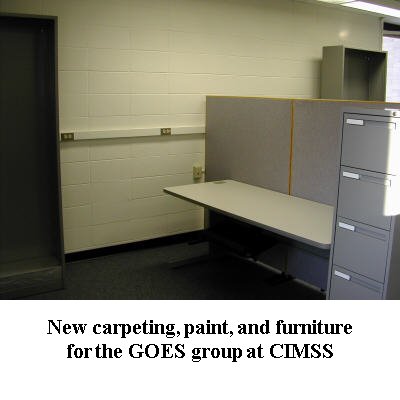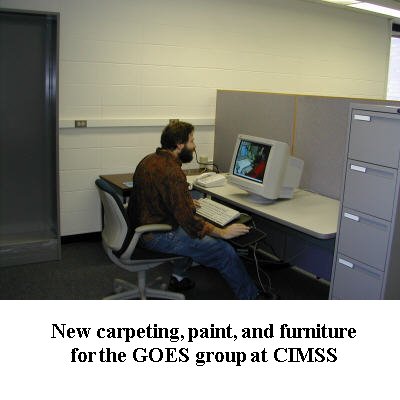
[ Archive ]

 |
CIMSS-NOAA Weekly Report
[ Archive ] |
 |
IN THE PRESS:
ITEMS FOR THE ADMINISTRATOR:
ITEMS FOR THE ASSISTANT ADMINISTRATOR:
ITEMS FOR THE OFFICE DIRECTOR, ORA:
ACCOMPLISHMENTS:
Multi-year Comparison of GOES and AVHRR Fire Products:
As part of an ongoing collaboration with A. Setzer of the Brazilian Instituto
Nacional de Pesquisas Espaciais (INPE), Geostationary Operational Environmental
Satellite (GOES)-8 Automated Biomass Burning Algorithm (ABBA) fire products
were compared with National Oceanic and Atmospheric Administration (NOAA)
Advanced Very High Resolution Radiometer (AVHRR) INPE fire products for
the past seven fire seasons (1995-2001). Results show that the INPE AVHRR
fire product detects more fire pixels in a single time period than the
GOES-8 ABBA at that same time period, especially in the Cerrado (grassland)
region where the fire intensities are generally lower than that observed
in the forested regions. When comparing diurnal GOES-8 ABBA composites
with the daily INPE AVHRR fire product, the GOES-8 ABBA typically detects
2 to 5 times as many unique fire pixels. This demonstrates the importance
of high temporal monitoring to capture agricultural burning in South America
where the fire signals are often detectable by satellite for only a few
hours. (J. Feltz, CIMSS, 608-263-3434; E.
Prins, E/RA2, 608-263-6607)
(Click on image for full size)
Figure Caption: The NOAA AVHRR INPE fire product was compared to the GOES-8 ABBA fire product at 2045 UTC and the GOES-8 ABBA daily unique fire composite for the past seven years. The figure shows the comparison for 3 years: 1.) 1995, the most active fire season, 2.) 1997, another active season with a drought in Northern Amazonas and 3.) 2000, the least active fire season. The daily unique GOES-8 ABBA composite, consisting of unique fire pixels detected at 1145, 1445, 1745, and 2045 UTC (c,f,i), clearly shows that the extent and concentration of fire activity is much greater than that indicated by observing at a single time period by GOES (a,d,g) or AVHRR(b, e, f).
Experimental GOES Imager Clear Sky Brightness
Temperature Monitored by Modelers: The European Centre for Medium-range
Weather Forecasts (ECMWF) is doing continuous "offline" monitoring of Geostationary
Operational Environmental Satellite (GOES) Clear Sky Brightness Temperature
(CSBT) data. Preliminary results are positive. The ECMWF plan is to monitor
the CSBTdata operationally by the end of January 2002. The next step, which
has already began, is the assimilation experiments. The Environmental
Modeling Center/National Centers for Environmental Prediction (EMC/NCEP)
is also bringing the experimental GOES imager clear-sky brightness temperatures
into their operational data tanks, although the data are not being assimilated.
(T. Schmit, E/RA2, 608-263-0291,
T.
Schreiner , CIMSS, 608-263-6754)
(Click on image for full size)
ITEMS FOR THE DIVISION CHIEF, ARAD:
ACCOMPLISHMENTS:
Real-time Polar Cloud and Radiation Product Updated: The experimental near real-time Web product providing retrievals of polar surface, cloud, and radiative properties from the Advanced Very High Resolution Radiometer (AVHRR) the National Oceanic and Atmospheric Administration (NOAA)-16 satellite has been upgraded from a developmental version to a stable release (version 1.0). The product is available at http://stratus.ssec.wisc.edu/products/rtcaspr. (J. Key, E/RA2, 608-263-2605)

New Version of Polar Cloud Toolkit Released:
A new version of the Cloud And Surface Parameter Retrieval (CASPR) system
for the Advanced Very High Resolution Radiometer (AVHRR) has been released.
CASPR is intended for use with high-latitude data, and contains procedures
to estimate surface temperature and albedo, cloud amount, particle phase
and size, optical depth, temperature, and both surface and top of the atmosphere
radiative fluxes. The new version has improved cloud detection, suport
for the National Oceanic and Atmospheric Administration (NOAA)-16 AVHRR/3,
additional output formats, and many other improvements. More information
is available at http://stratus.ssec.wisc.edu/caspr.
(J. Key, E/RA2, 608-263-2605)
VISITORS:
NEXT WEEK:
T. Schmit will convene a Geostationary Operational Environmental Satellite (GOES)-side Sounding Product Oversight Panel (SPOP) on January 24th at the National Oceanic and Atmospheric Administration (NOAA) Science Center. Topics will cover the status of all current "Top Ten" items as several new items. T. Schmit will attend an Advanced Baseline Sounder (ABS) Data Compression Meeting on Friday-January 25, 2002 in Suitland, MD. (T. Schmit, E/RA2, 608-263-0291)
LOOKING AHEAD:
IN THE PRESS:
ITEMS FOR THE ADMINISTRATOR:
ITEMS FOR THE ASSISTANT ADMINISTRATOR:
ITEMS FOR THE OFFICE DIRECTOR, ORA:
MODIS Data Used to Simulate Full-Disc ABI Scene:
MODerate-resolution Imaging Spectroradiometer (MODIS) data have been used
to simulate a pseudo-true color geostationary image. A composite
that includes a blue channel was created. The blue channel is being
considered for the Advanced Baseline Imager (ABI) on the next generation
geostationary satellites. The addition of the blue channel on the
ABI would allow the creation of pseudo-true color full disc images at regular
intervals (in addition to visibility products) during the day. (K.
Strabala, CIMSS, 608-263-8752)
(Click on image for full size)
Figure caption: This composite of simulated Advanced Baseline Sounder data in Geostationary Operational Environmental Satellite (GOES) projection was generated using 2 days (3-4 June 2001) of MODerate-resolution Imaging Spectroradiometer (MODIS) global data channels 1, 2 and 3 (red, green, blue) with the Man computer Interactive Data Access System (McIDAS).
ITEMS FOR THE DIVISION CHIEF, ARAD:
Office Renovation at CIMSS Complete:
Researchers working at the University of Wisconsin's Cooperative Institute
for Meteorological Satellite Studies (CIMSS) have moved back into their
newly renovated office space. Eight employees have moved all of their
materials including computers, office equipment, electronic storage media,
books, journals, and other office papers and are unpacking into new furniture.
Painting began Monday, January 14 and carpeting began Tuesday, January
15. The new furniture was installed January 17 and the employees
moved back in on January 18; pictures of the room before and with the new
furniture are at http://cimss.ssec.wisc.edu/goes/renovate211.
The renovation was funded by the Office of Research and Applications and
CIMSS. (M. Gunshor , CIMSS, 608-263-1146)


NEXT WEEK:
LOOKING AHEAD: